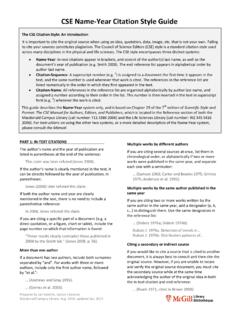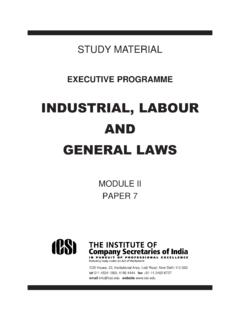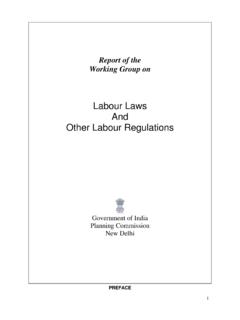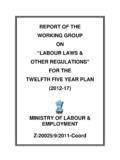Transcription of The Work, Family, and Equity Index - mcgill.ca
1 The Work, Family, and Equity Index Setting the Global Floor : a comparative study of labour standards in india and China Baijayanta Mukhopadhyay Chunbao Liu Jody Heymann 2 The Work, Family, and Equity Index (WFEI) has been developed by the Project on Global Working Families to measure governmental performance around the world in meeting the needs of working families. The indicators in the WFEI were selected to provide an evidence-based assessment of policies crucial to the needs of working families in general and low- and middle-income working families in particular. In compiling the WFEI, data were gathered on labour practices from 180 countries, representing a wide range of political, social and economic systems. These include maternity, paternity and parental leave; infant and toddler care; breastfeeding breaks at work; paid leave to meet children s health and educational needs; maximum hour limits, overtime limits, annual leave, mandatory day of rest and other standards; paid leave and flexibility for health care support for adult family members, family events and other extraordinary circumstances; and paid leave and flexibility for workers own health needs.
2 The authors would like to thank the McGill india Strategic Research Initiative for its support. We would also like to thank Gonzalo Moreno Ruiz de Elvira and Talia Bronstein for their invaluable help in preparing the report for publication, through tireless hours of formatting and reference checks. Project on Global Working Families Montreal, QC; Boston, MA All rights reserved. The Project on Global Working Families The Institute for Health and Social Policy 1130 Pine Avenue West, Montreal, QC. H3A 1A3 Tel: +1(514) 398-2027 About the Institute for Health and Social Policy The Institute for Health and Social Policy at McGill University was created to conduct and support world class research into the impact of social conditions on health and to lead programs designed to translate research findings into policies and programs on national and global scales that change the social conditions under which the worst off live.
3 Among other initiatives, the Institute is committed to the creation of a unique health and social policy data center that can be used by researchers and policymakers alike to examine the effects of social and economic policies on health worldwide. The Institute is also committed to building collaborations with policymakers and to developing model programs in order to address health needs. About the Work, Family, Equity Index Acknowledgements 3 Table of Contents Future List of Tables Table I: Hour restrictions in shops and establishments in Indian states Table II: Overtime hours and conditions in Indian states Table III: Annual leave in selected Indian Table IV: Sick leave conditions in Indian states Table V: National standard of the maximum period of sick leave in Table VI: Maximum period of sick leave in Table VII: Discretionary leave in Indian states Table VIII: Length of paid paternity leave as awards for childbirth after age 24 in Chinese Table IX: Length of paid maternity leave as awards for childbirth after age 24 in Chinese Table X: Length of paid maternity leave as awards for single-child parents in Chinese 4 Abstract The integration of China and india into the world economy has had an important impact on the world s labour market.
4 The redistribution of global industry, resulting from increased competition for capital, has heightened attention to Indian and Chinese labour standards. This study examines labour standards in india and China. We examine labour laws at the national and sub-national levels in both countries and compare them to global standards. Many of China s standards are recent and demonstrate a single overarching approach to all employment contracts in the country. india s approach is older and less centralized, covering different industries and sectors through different laws . However, internal debates within both countries mean that the response to workers well-being is evolving over time. International legal standards that are not met include the ILO s Reduction of Hours Recommendation ( india ), the ILO s Holidays with Pay Convention (many Indian states and a large segment of Chinese workers), and the 14-week maternity leave standard ( india and China).
5 Examples of rights that have been legislated include mandatory day of rest and compensation for overtime. Sub-national variation is detailed in the article. Although legislated standards clearly indicate what can be attained for workers within india and China, legislation alone is only a first step. For workers in both countries, implementation of laws both countries have already passed is an essential next step. 5 Introduction In the past few decades, we have witnessed a growing concern about working conditions in emerging economies, such as China and india . China s labour market has greatly expanded since the launch of economic reform in 1978;1 between 1978 and 2006, its total workforce increased from million to million and the number of registered employees in urban sectors increased from million to million, largely due to population growth and rapid A majority of these new jobs were created by state-owned enterprises and collective-owned enterprises before However, employment in these enterprises experienced a drastic drop, from million workers in 1995 to million workers in More than two thirds of workers who left these enterprises were reportedly absorbed by rapidly expanding private and foreign-funded In rural areas, although each farmer is granted access to a piece of land, an increasing number of residents have been seeking off-farm work.
6 In 2006, million workers were employed in local township and village enterprises, as well as in the private sector, and million more found jobs in However, most migrant workers have long faced discrimination, without de facto access to social Ever since the issue of the first Draft labour Contract Law in 2006, there has been an intense debate amongst government officials, industrial leaders, intellectuals and the public on whether labour standards and working conditions should be The draft was proposed primarily to ensure that contracts are in place to affirm the employment relationship, thereby 1 For an overview of China s labour market development, see ILO & Ministry of Ministry of Labor and Social Security ( ), An Employment Agenda for China: Background Paper for the China Employment Forum (2004), available at ; Ran Tao, The labour Market in the People s Republic of China: Development and Policy Challenges in Economic Transition, in Labor Markets in Asia: Issues and Perspectives at 519 (Jesus Felipe & Rana Hasan eds.)
7 , 2006). 2 National Bureau of Statistics of China, Zhongguo Tongji Nianjian [China Statistics Yearbook] 2007 . 3 Angang Hu, Economic Growth and Employment Growth in China (1978 2001), 3 Asian Econ. Papers 166 (2004). 4 National Bureau of Statistics of China, supra note 3. 5 This absorption was demonstrated by the fact that the majority of those who left these enterprises did not end up unemployed. Recent surveys find that between 1996 and 2002 the unemployment rate among urban residents averaged about 8 per cent. Fang Cai, Zhongguo Chengzhen youmeiyu Jiuye zengzhang? [Is There Employment Rate Increase among Urban Residents in China?] available at 6 National Bureau of Statistics of China. Di'erci Quanguo Nongye Pucha Zhuyao Shuju Gongbao (diyihao) [Communique on Major Data of the Second National Agricultural Census of China ( )] (Feb. 21, 2008). 7 Peilin Li & Wein Li, Economic Status and Social Attitudes of Migrant Workers in China.
8 15 China & World Econ. 1 (2006). 8 For an overview of the recent development of China s labour law, see Ronald Brown, Understanding Labor and Employment Law in China (2009); Law and labour Market Regulation in East Asia (Sean Cooney et al. eds., 2002); Aaron Halegua, Getting Paid: Processing the Labor Disputes of China s Migrant Workers, 26 Berkeley J. Int l L. 254 (2008); Virginia Ho, From Contracts to Compliance? An Early Look at Implementation under China s New Labor Legislation, 23 Columbia J. Asian L. 34 (2009). 6 making it easier for workers to claim their The main argument against the draft was that it might negatively affect China s appeal as a destination for foreign investment, thereby reducing employment. The law was unanimously approved by the Standing Committee of the National People s Congress (SCNPC) on June 29, 2007. In theory, this law would significantly improve working conditions in China, in particular for hundreds of millions of migrant workers, although the effects of its implementation remain to be seen.
9 In contrast with the trends towards formalisation apparent in China, and despite robust economic growth in the past two decades, evidence demonstrates that india s labour force remains largely in the informal economy, which is not effectively covered by labour india s labour force consisted of about 430 million persons in 2005, growing annually at about 2 per cent. The main driver of india s high growth has been the IT sector, which constituted 7% of GDP in 2008; however, the workforce in this sector will remain at million, which is a miniscule proportion of india 's Similar to China, agriculture has traditionally borne the brunt of india s economy, but its share of the workforce has declined, from 70 per cent in 1980 to 55 per cent in 2005. During the same period, industry s share in the Indian workforce rose by some 2 per cent, mostly in construction. The last two decades have seen a shift in formal manufacturing employment into the small factory and informal sectors.
10 The majority of former agricultural workers have found jobs in informal service Estimates show a range of proportions of formal sector workers in india depending on the industry involved, with 35% to 45% of rural Indians and 45% to 53% of urban Indians working in the formal . Even if india 's workers in the informal economy are not covered, the absolute number of Indian workers protected by the country's labour laws still reaches into the hundreds of millions, emphasising their importance. 88% of Indians working in the education sector, 82% of those working in the mining sector and 75% of those working in the manufacturing sector in india are covered by legislation. The most striking gap in Indian labour law is in agriculture, where only 5% of workers have their conditions Furthermore, many laws in india s patchwork of labour legislation either extend or have the potential to extend to the informal sector; for example, the federal Minimum Wages Act allows government to regulate working hours and overtime conditions for any categories of worker it chooses.



















